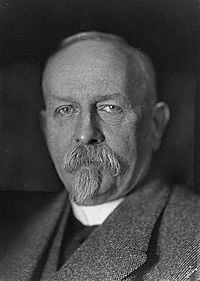Waldemar Christofer Brøgger (geologist) facts for kids
Quick facts for kids
Waldemar Christofer Brøgger
|
|
|---|---|

Brøgger in 1922
|
|
| Born | 10 November 1851 Oslo, Norway
|
| Died | February 17, 1940 (aged 88) Oslo, Norway
|
| Nationality | Norwegian |
| Alma mater | University of Oslo |
| Known for | Formation of rocks |
| Awards | Murchison Medal (1891) Wollaston Medal (1911) Fellow of the Royal Society |
| Scientific career | |
| Fields | geology |
| Institutions | University of Stockholm |
| Doctoral students | Victor Moritz Goldschmidt |
Waldemar Christofer Brøgger (born November 10, 1851 – died February 17, 1940) was a famous Norwegian geologist and mineralogist. Geologists study the Earth's rocks and history. Mineralogists study minerals.
Brøgger's work on igneous rocks in the Oslo area was very important. These rocks formed from hot, melted material deep inside the Earth. His research helped us understand how different types of rocks are made.
Contents
About Waldemar Brøgger
Early Life and Education
Waldemar Brøgger was born in Christiania, which is now Oslo, Norway. His father was Anton Wilhelm Brøgger. His mother was Oline Marie Bjerring.
He went to Oslo Cathedral School and finished in 1870. He then studied science and zoology at the University of Christiania, now called the University of Oslo. His teacher was Theodor Kjerulf.
Brøgger earned his degree in 1870. He completed his main research paper in 1875. After that, he started working as an assistant at the Norwegian Geological Survey.
Travels and Early Work
In 1875 and 1876, Brøgger traveled with his friend Hans Reusch. They visited Corsica and Elba. They wrote a book together called Jættegryder ved Christiania (Giant's Kettles near Christiania). This book was also published in German and English.
University Career
Brøgger became a helper at the Stockholm University mineral collection in 1876. He became a research fellow in 1878. From 1881 to 1890, he was a professor at Stockholm University. He taught about minerals and geology.
In 1890, he moved back to the University of Christiania. He became a professor of mineralogy and paleontology. He held this job until 1916. He was also the head of the math and science department from 1899 to 1902. Later, he became the rector (like a president) of the university from 1907 to 1911.
Important Discoveries
Brøgger studied igneous rocks in Norway and South Tyrol. He compared them to learn how different rocks are related. He was very interested in how rocks change as they cool down from hot magma.
He also studied older rocks in Norway. These are called Palaeozoic rocks. He looked at how the sea level changed in the Oslo area after the last ice age.
Brøgger is also known for suggesting how certain rocks called pegmatites form. He thought they formed when melted rock mixed with very hot water.
Selected Works
Here are some of the books and papers Brøgger wrote:
- Jættegryder ved Christiania (with Hans Reusch. 1874)
- Paradoxidesskifrene ved Krekling (1878)
- Die Mineralien der Syenitpegmatitgänge der südnorwegischen Augit- und Nephelinsyenite (1890)
- Fridtjof Nansen 1861–1893 (with Nordahl Rolfsen, 1896)
Awards and Honors
Brøgger received many awards for his work. In 1895, he became a knight in the Order of St. Olav. This is a high honor in Norway. In 1902, he was promoted to a commander.
He also received honors from other countries. These included the Order of the White Rose of Finland and the Swedish Order of the North Star. He was also a knight of the Order of Dannebrog from Denmark.
He became a member of the Royal Swedish Academy of Sciences in 1890. He was also a Fellow of the Royal Society in London. This is a very respected group of scientists.
Universities also gave him special degrees. He received an honorary Ph.D. from the University of Heidelberg. He also got an LL.D. from the University of Glasgow in 1901.
He won two important medals from the Geological Society of London. He received the Murchison Medal in 1891. He was given the Wollaston Medal in 1911.
Family Life
In 1878, Waldemar Brøgger married Antonie Sophie Wilhelmine Scheel Siewers. He passed away in Oslo in 1940. He was buried at Vår Frelsers gravlund.
His son, Anton Wilhelm Brøgger, became a politician. Waldemar Brøgger's grandson, Waldemar Christofer Brøgger, was a writer. He was named after his famous grandfather.

